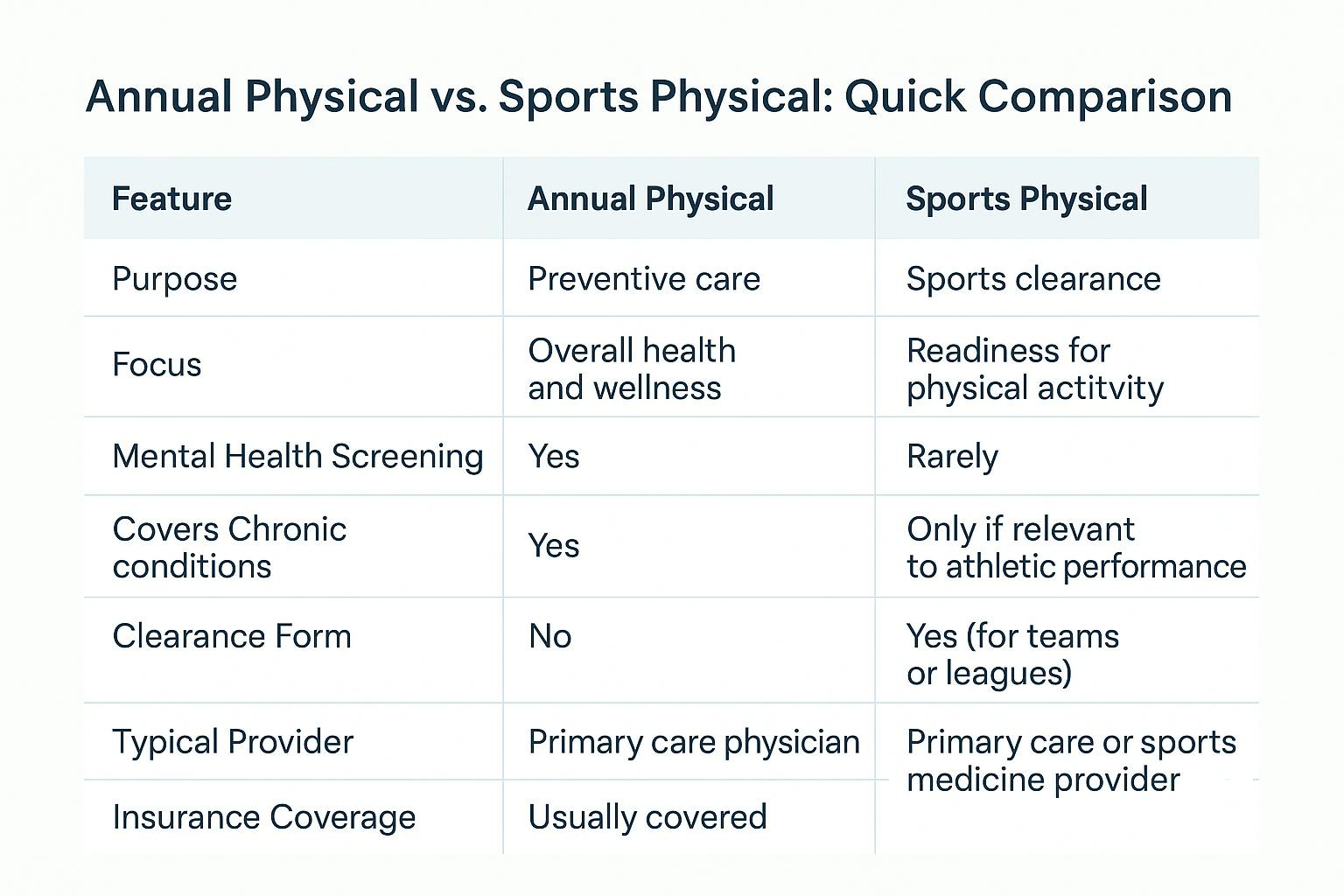Key Takeaways
An annual physical is a comprehensive wellness check that helps monitor overall health, manage chronic conditions, and prevent future illness.
A sports physical evaluates your physical readiness for athletic activity and identifies any risk factors that could lead to injury.
Some individuals may benefit from both types of exams, especially if they are starting a new sport, managing medical conditions, or have not had a full checkup in the past year.
Are you a student-athlete, weekend warrior, or parent trying to schedule a physical? You may notice two types of appointments popping up: sports physicals and physical exams. While they sound alike, they serve very different purposes. Knowing the difference can help you schedule the right exam at the right time.
We’ll explore what each exam includes, how they’re used, and when you might need both.
What is Included in an Annual Physical Exam?
An annual physical exam, also called a wellness exam or preventive care visit, is a full checkup focused on your overall health. It’s typically recommended once a year and is often covered by insurance.
During this visit, your provider may:
- Review your personal and family medical history
- Measure height, weight, and body mass index (BMI)
- Take vital signs (blood pressure, heart rate, etc.)
- Perform a full physical exam
- Order lab tests if needed
- Discuss topics like nutrition, exercise, sleep, and mental health
- Review or update your immunizations
Annual exams are preventive. They help detect early signs of illness, manage chronic conditions, and support long-term wellness. These visits are usually performed by your primary care provider, such as a family medicine doctor, internist, or pediatrician.
What Does a Sports Physical Exam Include?
A sports physical, or pre-participation physical evaluation (PPE), is designed to determine whether it’s safe for you to participate in a sport or physical activity.
These exams are often required before joining a school team, camp, or recreational league—a sports physical focuses on your physical readiness for activity and potential injury risks.
Your provider may:
- Review your medical history and previous injuries
- Perform an exam of your heart, lungs, joints, and muscles
- Ask about your current activity level and training goals
- Evaluate any physical limitations or risk factors
- Complete a sports clearance form (if needed)
While sports physicals may be done by a range of healthcare providers, they are typically performed by sports medicine doctors or your primary care provider.

Which Type of Physical Exam Is Right for You?
- Physical exams provide a comprehensive view of your overall health, including emotional well-being, management of chronic conditions, and long-term prevention strategies.
- Sports physicals are more targeted and focused on your ability to participate safely in a specific activity.
Do I Need Both a Sports Physical and Physical Exam?
It depends on your age, activity level, and health history.
If you're already scheduling an annual checkup, your provider may be able to complete the sports clearance during the same visit. However, not all sports organizations accept an annual physical in place of a designated sports physical.
You may benefit from both exams if:
- You haven’t had a full wellness check in the past year
- You’re beginning a new sport or training program
- You have existing medical conditions that need close monitoring
- You want to make sure your insurance covers both types of visits.
Best Time to Schedule a Sports Physical or Physical Exam
If you're starting a new sport or season, book your sports physical 4–6 weeks in advance. This allows enough time to address any concerns or obtain additional testing if needed.
Annual physical exams can be scheduled at any point during the year. Many people choose to book theirs around a birthday, at the start of the school year, or after the holidays as part of a new health routine.
Get the Right Physical for Your Health and Fitness Goals
Whether you're starting a new workout routine, joining a sports team, or just staying on top of your health, choosing the right type of physical exam matters. Understanding the difference between an annual physical and a sports physical ensures you get care that fits your needs.
Still unsure? Talk to your CLS Health provider—they’ll help you decide based on your age, activity level, and medical history.





